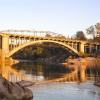That DAM road!
#16

Posted 01 March 2003 - 11:16 PM
#17

Posted 02 March 2003 - 07:45 AM
Too much is at risk. A truckload of explosive is all it takes, similar to the OK Federal building scenario. It is also quite easy for terrorists to pull this one. It does not need the hijacking of any airline with 5 terrorists. Sacramento will be 12 feet under water, and Mr. Bush and the Republicans can say good bye to the re-election. If it happens, this will be bigger than the NYC and Pentagon 9/11……………

#18

Posted 02 March 2003 - 01:26 PM
#19

Posted 02 March 2003 - 04:54 PM
they could stop all trucks at the toll booth and turn them around. Do not let the
trucks cross the bridge. Use the money, at least at first, to pay for security. Get
enough armed guards to keep the dam road safe. We would do this until the new
bridge is built. Once the bridge is built, close the dam road, and if necessary charge
a toll for the new bridge for a few years.
#20

Posted 02 March 2003 - 06:06 PM
#21

Posted 02 March 2003 - 06:17 PM
If the City of Folsom were somehow able to charge $1.00 a day for non-resident commuters using any of the current Folsom bridges it would be great for us. Some non-residents who commute through Folsom want to make the sales tax argument; if that's the case then each non-resident commuter would have to spend over $13.00 a day in Folsom on TAXABLE items, (which does not include a lot of groceries) to equal the $1.00 a day toll proposed.
At any rate, the dam road is not going to reopen to the general public. People who use it need to decide what it's worth to them to have an alternative crossing to the dam road.
#22

Posted 02 March 2003 - 06:31 PM

#23

Posted 03 March 2003 - 08:07 AM
The idea might fly if for a limited time period just to pay for the bridge but think about it-----Folsom is not San Francisco with the Golden Gate, Pacific Ocean, Chinatown, etc., etc.,
The tolls over the bridges into that city have NEVER gone away, for tourists, employees, and residents. Those tolls keep going up. To even get into or out of the East Bay area most of the bridges have tolls.
Would we then want to have to pay to go over the Watt or Hazel bridge corridors? ----Or the causway between Davis and Sac? A toll to get into Folsom might do more harm than good. But I, like all of you----would just like to see something done that was needed long ago!
It all goes back to the petty wrangling of the politicians!!
#24

Posted 03 March 2003 - 01:09 PM
I don't want the Dam to reopen. It is an ideal target for terrorist. When I first moved here, I always wondered why they would let the dam road become a thorough way for traffic. It seemed like such a huge risk. I'm glad that someone finally saw that and corrected this by closing it.
I agree with others that a bridge and/or connecting Oak Avenue Parkway would be a better solution.
"Our strength will be found in our charity." [Betty J. Eadie]
"Being a mom is the most rewarding job I have ever had!"
"SEMPER FIDELIS! USMC"
#25

Posted 03 March 2003 - 01:14 PM
| QUOTE |
| I'm not sure how the merchants and businesses would feel about a toll. The idea might fly if for a limited time period just to pay for the bridge but think about it-----Folsom is not San Francisco with the Golden Gate, Pacific Ocean, Chinatown, etc., etc., The tolls over the bridges into that city have NEVER gone away, for tourists, employees, and residents. Those tolls keep going up. To even get into or out of the East Bay area most of the bridges have tolls. Would we then want to have to pay to go over the Watt or Hazel bridge corridors? ----Or the causway between Davis and Sac? A toll to get into Folsom might do more harm than good. But I, like all of you----would just like to see something done that was needed long ago! It all goes back to the petty wrangling of the politicians!! |
A very good point. Oncce a toll was implemented, it would never go away. This is something that should be paid by both Sac & Placer Counties, which would be the main users of a bridge.
#26

Posted 03 March 2003 - 03:18 PM
| QUOTE (OctoberLily @ Mar 3 2003, 01:09 PM) |
| I think they also need to expand Folsom Auburn Road. It is a one lane road going to and from Roseville. They need to expand Folsom Auburn because the traffic has increased since both Roseville and Folsom have grown in population. |
This has been in the planning stages for a while now. Folsom is going to widen its portion first, but if I recall correctly, Placer County is going to widen their portion a few years later. Here's something I found on, though it's more than a year old, it should give you some idea of what's going to happen:
http://www.placer.ca...lsom_notice.htm
I just noticed that the "Project Home" link near the bottom of that page describes Placer County's plans for widening their portion. According to the "Schedule" link, construction on the Placer County portion is scheduled to begin in about a year.
#27

Posted 09 March 2003 - 07:47 AM
But officials emphasize there's no evidence that terrorists have targeted the Folsom structure.
By Matthew Barrows -- Bee Staff Writer
Published 2:15 a.m. PST Sunday, March 9, 2003
In making the decision last month to close Folsom Dam Road, federal officials say they were responding to a recent analysis by the Defense Department that singled out Folsom Dam as a top potential target among U.S. dams.
Officials at the Bureau of Reclamation, the federal agency that operates the dam, say there is no evidence that terrorists have focused on the 480-foot dam.
And, even if they had, blowing up a massive concrete structure like Folsom Dam would be an extremely difficult task, especially from the road atop the dam, according to experts in explosives and dam safety.
But bureau officials say the consequences of such a remote event -- including a potential loss of life many times greater than the World Trade Center disaster -- prompted them to close the heavily traveled road for good.
According to those who have seen the report, the Defense Department analysis used something called CARVER, a system developed by the CIA and the military in the 1960s to assess the vulnerability of enemy targets.
"The more they looked at Folsom, the more it climbed up the list," said the bureau's Jeff McCracken.
The system grades a potential target on six criteria: how critical it is to a region; its accessibility; how quickly it could be rebuilt; its structural vulnerability; the effects of a breach in terms of death and loss; and how recognizable the target is.
Leo Labaj is a former CIA counterterrorism official who now works for Telemus Solutions, a security analysis firm in Northern Virginia that uses the system.
"The nice thing about CARVER is that you're looking through the eyes of the adversary," Labaj said. "It helps define what is most attractive to a terrorist."
Labaj said Folsom Dam would have distinguished itself from other dams in two categories.
Given that 900,000 people live in the shadow of the dam, Labaj said, it would have registered high marks in effects. And he said it also would have scored high in accessibility because, until Feb. 27, it was one of only two dams in the West with a public road at its top.
"It may have gotten a '5' (out of 5) in that category," Labaj said. "By closing off that road, you take accessibility down to a '2.' "
Labaj said dams usually don't make good targets, however, because they are so strong.
"It would take damn near a nuclear weapon to destroy some of these dams," he said. "Taking out a dam from on top -- that's a very hard thing to do."
Randy Rapp, an explosives engineering expert and Army Corps of Engineers veteran, agreed.
Rapp said a vehicle packed with explosives would kill anyone nearby, and would rip apart the road and concrete barriers. But damage to the dam itself, he said, likely would be minimal.
"I'm not so sure you would even get very much of a crater," he said. "Anything can happen, but I think the risk is low."
Both men pointed to the experience of a squadron of so-called dam-busters in World War II.
Midway through the war, the Royal Air Force attempted to destroy three dams in Germany's Ruhr Valley that supplied hydroelectric power to German industries.
To accomplish that, the British needed 19 bombers carrying cylindrical bombs specially developed for the mission. The bombs were designed to skip across the water when dropped to avoid German torpedo netting. And when they struck the dam wall, they sunk 30 feet before exploding so that the water pressure at that depth would help burst the dam.
Two of the three dams were breached, though the third held out despite being hit.
Still, Bureau of Reclamation officials say the dire results of a Folsom Dam failure outweigh the low risk and justify closing the road.
City of Folsom representatives, who traveled to Washington, D.C., last week to ask bureau officials to compromise on Folsom Dam Road and open it during commuting hours only, were sent home empty-handed. Among their arguments: that it didn't make sense to close the road when the dam remained vulnerable from the air and water.
"We're all having a hard time with the logic of having boats near the dam and planes fly over the dam, but banning traffic," said Folsom City Manager Martha Lofgren. "I would characterize that meeting as not very productive."
Lofgren said the city has borne the extra cost of managing added traffic since the road closed, and was told it would not be reimbursed by the bureau.
On Friday, Sen. Barbara Boxer, a California Democrat, wrote a letter to Transportation Secretary Norman Mineta requesting federal assistance for Folsom, which has had to handle the bulk of the traffic -- 18,000 vehicles a day -- that once used Folsom Dam Road.
And Lofgren said Folsom officials are drafting another proposal to open the road during certain times of the year.
But bureau officials said allowing cars on the road is not worth the potential penalty.
Folsom Dam holds back nearly a million cubic feet of water when full, enough to cover the entire state of Rhode Island with 1 1/2 feet of water. A sudden failure would unleash a tidal wave that would roar through Sacramento County and into the Delta, sweeping up anything in its path.
In 1997, the Bureau of Reclamation simulated what would happen in a worst-case scenario involving the dam: a catastrophic breach -- meaning it essentially crumbles -- when the reservoir is full, as it generally is in mid-spring.
One hour after Folsom Dam failed, according to the simulation, the surge would be just above Nimbus Dam. After two hours, it would reach Carmichael, putting hundreds of homes on the north bank of the American River under as much as 8 feet of water.
After three hours, the surge reaches California State University, Sacramento, and by four hours the water would start rising in downtown Sacramento, running up the steps of the state Capitol.
The Pocket area and other low-lying spots along the Sacramento River would be among the hardest hit, with up to 10 feet of water accumulating in five hours.
After six hours, a layer of water would stretch over a huge swath of the region, from Sacramento International Airport to the town of Freeport.
Loss of life would depend on a number of variables, including the time of day such an event occurred.
Bureau officials, however, said 160,000 homes would be inundated, along with hospitals, highways and schools. Property damage would be as a high as $40 billion.
The water supply to 100,000 people would be cut off. The amount of electricity the dam produces -- enough to run the city of Sacramento for a year -- would be lost.
"It would be catastrophic," McCracken said.
The specter of such consequences has spurred the bureau to begin implementing a security plan that includes putting concrete barriers on both sides of Folsom Dam Road and, in coming weeks, installing barriers in front of the dikes that ring the lower portion of Folsom Lake. The bureau's worst-case scenario also lays out the effects of breaches in the dikes, some of which also would result in major flooding.
McCracken said the bureau is working to develop an apparatus that will keep boats on the lake side of the dam from approaching the structure.
"They won't be able to get close," he said.
A private security force that began patrolling the dam and the area around it a year ago has been augmented in recent weeks.
McCracken said officials also are considering possible protections against an attack on the dam from an airplane.
Dam engineers warn that an attack on a dam, even if it didn't create an opening immediately, could be dangerous in the long run.
The pressure on the lake side of a dam is so great that the water there is constantly seeking out and exploiting weaknesses in the structure.
In 1976, for example, the newly built Teton Dam in eastern Idaho collapsed after water seeped into the internal workings of the earthen structure and eroded it from within.
The failure unleashed a torrent of water that killed 11 people, drowned 16,000 cattle, forced 25,000 people from their homes and swept the town of Sugar City from the map.
Despite the potential disruption posed by a dam break, Labaj, the security analyst, said that when he was with the CIA the agency rarely targeted dams because they required such a great effort to destroy.
Even so, he said, in today's climate, protecting Folsom Dam is only prudent.
"There's a penalty there that's so great that you may want to take extraordinary steps," he said.
The Bee's Matthew Barrows can be reached at (916) 321-1008 or mbarrows@sacbee.com.

#28

Posted 10 May 2003 - 06:00 PM
I came here to retire and enjoy the peace and quiet of our secluded property.
#29

Posted 10 May 2003 - 09:15 PM
#30

Posted 12 May 2003 - 04:22 AM
1 user(s) are reading this topic
0 members, 1 guests, 0 anonymous users


















